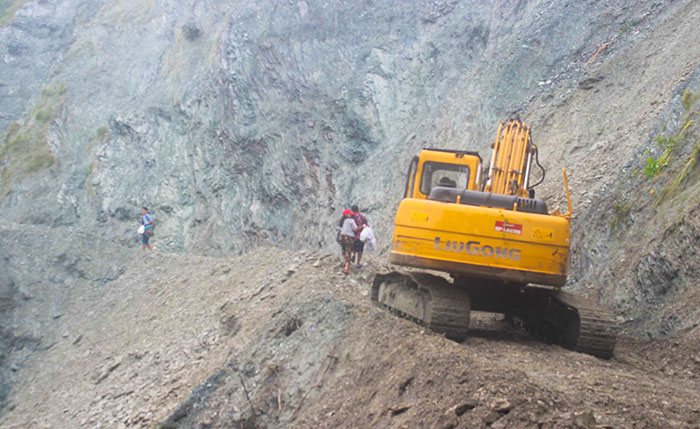DoR spends over Nu 6.5 million annually
Nima | Gelephu
Keeping the Gelephu-Trongsa highway is not only a tedious job with several areas prone to landslides, but costs the government in the millions.
For the past five years, the Department of Roads (DoR), Sarpang spent over Nu 6.5 million (M) annually to keep the Gelephu-Trongsa primary national highway open at all times.
At the notorious Box Cut – about 15 kilometres away from Gelephu – over Nu 22M were spent on road clearing works and building road mitigation structures since 2014.
Most of the major roadblocks this monsoon, like almost every year, were reported from Box Cut. The road at Box Cut was closed for over three days following a major landslide last week.
The continuous downpour at the site hampered clearing work. The repair works for machinery breakdown at the roadblocks are hampered because of the lockdown today.
DoR’s Chief Engineer Sonam Tashi said the department works throughout the day to keep the traffic open. “By the next morning, everything is washed away when it rains heavily,” he said. He added that the department tried to reduce the roadblock duration but are left without any option. “We are at the mercy of nature often,” said Sonam Tashi.
The highway connecting Zhemgang and Trongsa dzongkhags with Sarpang is blocked frequently at Aieslip, Box Cut, and Ossey, especially during monsoon.
The worst affected is Zhemgang dzongkhag that suffers a natural lockdown during monsoon when the roads are closed at Ossey and Box Cut towards Gelephu and at Rewtala towards Trongsa.
Commuters using the highway said there is a need for a permanent solution that could ensure roads are open throughout the season and to work towards it during the dry season.
DoR officials said the frequent roadblocks along the highway are because of the poor geological condition and incessant rainfalls.
Several structures were built along the road under various project initiatives in the past.
“The whole landscape becomes fragile during monsoon. With water seepage, the road becomes muddy and slippery. It causes landslides,” said Dhendup Dorji, an executive engineer with DoR.
He added that the number of heavy load carrying vehicles using the highway increased since the lockdown. “They carry a minimum load of 40 metric tonnes. The stone soiling is disrupted by heavy vehicles,” he said.
The DoR has not carried out any major restoration activity at the landslide area like Box Cut last year with the department tendering out works for geological studies.
The study would suggest the DoR with a solution to stabilise the stretch of road at Box Cut and Aieslip that experiences landslide during heavy rainfalls.
The tender for a geological study at Box Cut is awarded to an international consultant and at the Aieslip to a local consultant. The topography data and initial study at the sites are completed, according to DoR officials.
The geological study that would suggest engineering techniques and designs be used to built mitigation structures at critical landslide-prone areas like Box Cut, Aieslip, Rewatala along Gelephu-Trongsa highway is funded by Global Climate Fund.
The mitigation measures at Box Cut were implemented since the 1990s, according to DoR officials. However, it involved periodic road maintenance of retaining walls, and regular road clearing works that lasted only for few years.
The plans to built alternate routes from a checkpoint at Serzhong via the Tshachu area were also explored a few years back but the plan couldn’t come into effect.
Today, there are six excavators and one backhoe loader deployed along the Gelephu-Trongsa highway to clear the blockage at the shortest time possible.


